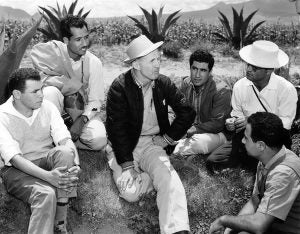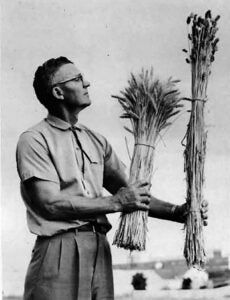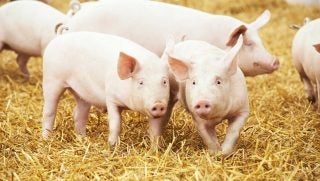“What is that crop growing on Cottonwood Road,” asked a visitor to my place last summer. “It looks like corn, but it’s too short, has straight-up leaves, and no tassels.” I explained to him it was a field of corn grown for seed, with improved genetics to allow for stronger plants and a higher yield.
So, how do these changes do that?
Shorter plants take less energy to grow, leaving more energy for seed production. Upright leaves don’t shade the leaves below, allowing the plant to catch more sunlight and maximize photosynthesis. Short plants with strong stalks are less vulnerable to lodging from extreme winds. And the tassels? They were there, just hidden a bit by the upright leaves.
Seed companies have been working on these varieties for years, trying to shorten the plants without reducing the size of the cobbs. Their efforts are now reaching farmer’s fields.
Tall corn, “up to an elephant’s eye” (from the musical Oklahoma) has always been the pride of a corn farmer, an indicator of strong, healthy, high-yielding plants. The same was true of wheat farmers prior to the 1950s. I have a picture of my grandfather proudly standing in a field of Jenkin’s Club wheat with plants up to his shoulders. The problem with tall wheat is the same as tall corn — it easily lodges (falls over). Wheat breeders understood this, and worked to shorten plants, beginning in the Pacific Northwest with Dr. Orville Vogel, a U.S. Department of Agriculture wheat breeder at Washington State College (University since 1959) in the 1930s.
With the advent of commercial fertilizers after World War II, the problem became more acute, as farmers tried to push yields above the norm of 30 to 50 bushels. Extra nitrogen weakened the stalks, and wouldn’t hold up the bigger, more productive heads.
Vogel and other Northwest breeders had considerable success in breeding shorter wheats in the late 1930s-early 1940s. In 1949, Vogel released the variety Brevor, which became a widely grown wheat in the Pacific Northwest. Also in that year, he crossed Brevor with a Japanese short-strawed variety, Norin-10, a cross that would ultimately result in igniting the Green Revolution.
In 1946, a USDA agronomist, Cecil Salmon, serving with Gen. Douglas MacArthur’s U.S. occupational forces in Japan, toured a number of Japanese experiment stations, noting many short-strawed, good yielding wheats. He took samples of 16 varieties and sent them to his bosses in Beltsville, Maryland. Agronomists there sent them to land-grant colleges around the U.S., but Vogel was the only breeder who took an interest in them, seeing the possibility of shortening varieties even further.
After another cross with the variety Burt, a final selection was named Gaines, the first semi-dwarf, high-yielding wheat in the world. In 1961, it was released to Pacific Northwest farmers.
Dr. Norman Borlaug, breeding wheat in Mexico for Mexican farmers, had doubled Mexico’s production in the ’40s by developing rust resistant varieties and encouraging responsible irrigation and adequate fertilizer. But lodging was a severe problem. He heard of Vogel’s short wheats, and requested some seeds. Vogel sent him 60 seeds of his Norin-Brevor-Burt cross in April of 1954, telling Borlaug they were winter wheat seeds and would likely not produce well because they would not vernalize in Mexico’s warm winters.
Borlaug planted most of the seeds, and when ready to receive pollen for a cross, pollen was taken from a rust resistant Mexican variety. But rust spores had landed on the pollen, and when introduced to the female parent (Vogel’s seeds, which were not resistant to Mexican rusts), rust killed them all.
Borlaug had eight of Vogel’s seeds left. He vernalized them in a refrigerator and planted them in pots in a greenhouse away from rust spores. When it came time to make a cross, he used the Vogel plants as the pollen source, and a Mexican variety as the female plant, thus avoiding the previous disaster. From the crosses of these eight seeds the Green Revolution was born.

Borlaug now had a base from which to build an exceptional variety. For a number of years he had pursued a speeded-up breeding program called “shuttle breeding,” in which he grew plants in northern Mexico in the summer, and southern Mexico in the winter — two crops a year. He did this against the advice of agronomists who said it wouldn’t work (Borlaug was a plant pathologist) because wheat is a photo-sensitive crop, initiating heading when days are lengthening, and staying vegetative when shortening.
But some plants made a head in both northern and southern Mexico, and it was from those plants he made improvements. Against all advice, he developed a day-length insensitive variety that used accumulated heat units as a signal instead of day-length to initiate heading. By accident, he developed a variety adapted to a wide range of climates and latitudes. In 1961 he released his new variety to Mexican farmers, the same year Pacific Northwest farmers got Vogel’s’ Gaines wheat.
During the 1960s, Borlaug’s varieties spread around Asia, spoiling starvation everywhere. India went from a predicted hopeless food shortage and mass starvation to a wheat exporter in the 1970s. Borlaug is rightly credited as the father of the Green Revolution that saved the lives of a billion people, but Orville Vogel, I argue, is the grandfather.

The sequel to the story is tragic. Millions of the poorest of the poor farmers could not or would not buy the new technology. They were displaced by those who could afford the new technology, and ended up in overcrowded cities, dependent on social services. Sociologists and many environmentalists say the Green Revolution has been a social failure, and we should have stuck with old varieties, less intense (organic) growing methods and let a billion people starve. How sad. How logically twisted.
Ultimately the world’s people have grown richer, better fed, and the environment — though many will disagree — is better off, because higher yields means less of the earth needs to be cultivated for crops. Feeding 8 billion people using the old varieties of wheat, corn, and rice, even with improved organic methods, is just not possible.
How much will the new corn varieties improve yields? Probably not doubling or quadrupling yields as Vogel’s and Borlaug’s wheats did, bit expect 300 bushel corn yields to become common in the near future.
Jack DeWitt is a farmer-agronomist with farming experience that spans the decades since the end of horse farming to the age of GPS and precision farming. He recounts all and predicts how we can have a future world with abundant food in his book “World Food Unlimited.” A version of this article was republished from Agri-Times Northwest with permission.



